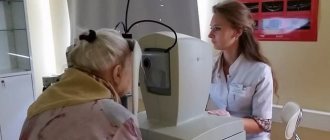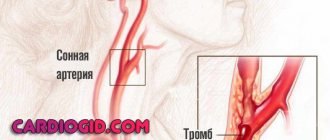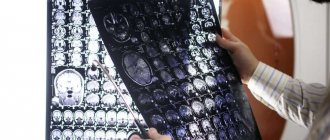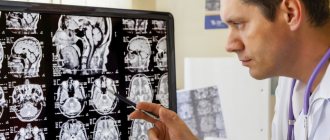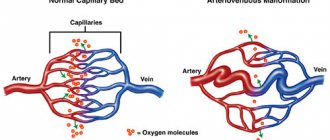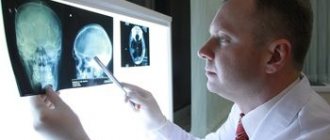Make an appointment by phone: +7 (343) 355-56-57
+7
- About the disease
- Cost of services
- Sign up
- About the disease
- Prices
- Sign up
A concussion is a form of traumatic brain injury. In which short-term memory loss may occur, brain dysfunction is reversible. Usually the cause is various traumatic situations. In case of injury, the protective fluid is not able to prevent the impact of brain tissue on the bone tissue of the skull. The injury requires hospitalization and consultation with a specialist.
Classification
Concussion is classified into three degrees:
1.
Mild degree.
The victim is conscious, and within half an hour after the injury there are typical complaints of headache, dizziness, nausea, and disorientation in space. After half an hour the condition returns to normal. 2.
Average.
Consciousness is preserved, short-term memory loss occurs, the symptoms are similar to mild, dizziness persists, there may be a headache, nausea, the victim is disoriented in space. 3.
Severe degree.
For her, loss of consciousness lasting a couple of minutes, maybe several hours, is accompanied by retrograde amnesia. Symptoms of headache, dizziness, nausea, disorientation in space can remain for two or three weeks, problems with sleep, and loss of appetite occur. Organic brain lesions lead to the appearance of vascular dementia. This is a secondary disease, that is, occurring against the background of some pathological process. The main reason is a previous ischemic or hemorrhagic stroke.
Diagnostics
To make a diagnosis, a number of examinations are carried out:
- medical history, neurological examination – obtaining initial information about the patient’s condition;
- MRI - allows you to detect swelling, hemorrhages, traumatic injuries;
- X-ray of the cervical spine - helps to detect or exclude fractures;
- checking the functioning of brain impulses.
If a concussion is suspected, a full medical examination is required to detect and prevent the development of complications caused by the injury.
A concussion can lead to the death of parts of the brain, damage to the inner ear, hemorrhages and fractures.
Symptoms of a concussion
General symptoms:
The victim complains of memory loss, dizziness, tinnitus, double vision, intense headache, nausea leading to vomiting, and fatigue. There is sleep disturbance, daytime sleepiness, irritability, and emotional lability. After the injury, confused speech appears, short-term memory loss (retrograde, anterograde amnesia), increased sensitivity to light, noise, balance is disturbed, uncoordinated movements, smell and taste are lost.
Symptoms that may bother you for a longer period:
- intense headache, may be migraine;
- difficulties with reading, remembering, writing;
- absent-mindedness, difficulty concentrating;
- nausea, vomiting;
- drowsiness, weakness;
- dizziness.
Clinical picture
A concussion is characterized by short-term depression of consciousness and single vomiting. Primary symptoms after a mild traumatic brain injury - increased breathing, changes in pulse and blood pressure - usually disappear quickly. However, if the patient has a history of hypertension or hypertensive reactions, blood pressure may persistently increase. This is due to the stress factors that accompany the injury.
Body temperature with mild traumatic brain injury remains within normal limits. Vasomotor reactions are possible (pallor, then redness of the face). People who have suffered a concussion are characterized by vegetative phenomena: flushing of the face, anxiety, sleep disturbances, sweating. In some cases, pain occurs when moving the eyes.
Treatment
Medicines are the cornerstone of treatment. During the first three weeks of headache, abortifacient medications are usually used. If headaches continue after three weeks, then additional therapy is prescribed.
Abortion therapy
The choice of abortive therapy depends on the type of headache. The main medications for the treatment of post-traumatic tension-type headaches are analgesics and NSAIDs. Muscle relaxants are more effective for PTTH than for regular tension headaches due to the presence of cervical muscle spasm. But these drugs are recommended to be taken only for 1-2 weeks. If the pain persists, then preventive treatment is necessary. If post-traumatic headaches are migraine in nature, then the same drugs are used as for migraines. Antiemetic drugs are effective for many patients. Primary abortive migraines include: Excedrin, aspirin, naproxen (Naprosyn or Anaprox), ibuprofen (Motrin), ketorolac (Toradol), Midrin, Norgesic Forte, Butalbital, Ergotamines, Sumatriptan, corticosteroids, narcotics, and sedatives.
Preventative treatment
During the first 2-3 weeks after injury, abortive drugs such as anti-inflammatory drugs are usually used. Most patients do not need to take daily preventive medications, and post-traumatic headaches gradually improve over time.
The most commonly used preventative treatments are antidepressants, especially amitriptyline (Elavil) or nortriptyline (Pamelor) and beta blockers. NSAID drugs often have a dual purpose, functioning as an abortifacient and preventive treatment. Antidepressants that have a sedative effect, especially amitriptyline, often reduce daily headaches while improving sleep. In severe cases, it is necessary to use both beta blockers and antidepressants. Non-drug treatment methods may include various physical procedures and acupuncture.
How to help the victim?
The first step is to call an ambulance, even if the person refuses, claiming that he is already better. Delay often leads to subsequent difficulties in carrying out diagnostic measures.
But giving any painkillers or other medications before the doctors arrive is strictly prohibited. In the best of circumstances, pharmacological agents will only blur the overall clinical picture. But in a more serious scenario, they will only harm a weakened body.
While others are waiting for specialists to arrive, the patient will need to provide:
- cold;
- hunger;
- peace.
It is better to start with the last point, which provides for mandatory bed rest in the safest possible environment. Moreover, it is extremely important not just to send a person to sit without unnecessary movements, but to move him to a horizontal position, limiting his mobility.
Recommends applying cold to the head. A heating pad with ice water, pre-wrapped in a towel, is best suited for these purposes. If you don’t have ice on hand, a simple cold compress made from a rag will do. Exposure time is up to 5 minutes.
It is also important to ensure that the victim’s head is slightly higher than the body itself. Open a window to allow fresh air to enter.
When, during the initial examination, it turns out that the patient is unconscious, the first task of those around him is to bring him to his senses. Having shifted the person to his side, it is worth going for ammonia. A cotton swab is moistened with the solution and then brought to the patient’s nose.
If a person constantly falls into an unconscious state, then it is better to leave him to continue lying on his right side, bending his left arm and leg 90 degrees. The head should be directed towards the floor. This will ensure complete intake of air into the lungs, as well as prevent tongue retraction or suffocation due to uncontrolled release of vomit.
You should not give the patient any alcoholic drinks “for courage,” as this will only increase the already significant load on the cardiovascular system, increase blood pressure, and increase cerebral edema. In cases where outpatient therapy is indicated, the person is not allowed to return to their usual pace of life.
During treatment, you will have to give up any physical activity, and also not watch TV or strain your eyes when working with a computer. If you follow such a simple rehabilitation program, you will be able to recover in approximately 2-4 weeks.
In some cases, for final confirmation of recovery, it is necessary to undergo auxiliary instrumental diagnostics. This can be either computed tomography or magnetic resonance imaging.
Causes of a concussion
Regardless of how the bruises were received, they end with the brain hitting the inner walls of the skull. The result is not long in coming, expressed in swelling of varying intensity. It is the swelling that causes the leading symptoms of a concussion to appear.
An external mechanical influence due to increased pressure on the head can provoke such a phenomenon. This definition even includes everyday hits against lockers or during a game of football. Sometimes this pathology is a consequence of a sharp fall or sudden braking of a vehicle.
In ordinary life, most often the victims of the condition are children of approximately school age who do not control their strength during various outdoor games, as well as elderly people who suffer from unsteady gait and often fall.
If you use the diagram of the main signs of a concussion, you can diagnose it for almost any person. The sooner medical care is provided to the victim, the faster he will complete his rehabilitation course. Even with consistently positive dynamics, recovery will take about a week. Reducing these periods threatens the development of complications.
It is impossible to predict how serious the consequences of ignoring an injury may be. It is believed that in the absence of timely medical care, patients in the future will not be able to quickly cope with even the simplest tasks. Such inhibition can be observed for months.
Also, untreated patients have an increased risk of developing:
- alcohol addiction;
- Parkinson's disease;
- sudden death.
To prevent a sad outcome, it is worth learning to recognize threatening symptoms and provide quality first-aid care.
Drug therapy
In the acute period, drug therapy is mandatory.
Analgesics and other pain relievers
Headache occurs in almost all patients with a concussion.
To relieve the syndrome, it is recommended to take:
- analgesics;
- non-steroidal anti-inflammatory drugs (NSAIDs).
For mild and moderate, diffuse and episodic pain, Analgin or Baralgin is prescribed. If the pain intensifies and is constantly present, taking Pentalgin, Tempalgin, Sedalgin is indicated.
If the pain syndrome is not relieved by the listed analgesics, NSAIDs are prescribed. They are taken only under the supervision of a doctor, since any medicine from this group can provoke bleeding if the blood vessels of the brain are damaged. Side effects when taking analgesics can also include dizziness and decreased blood pressure.
Analgesics for pain relief.
Sedatives for anxiety and insomnia
Neurological disorders during a concussion manifest themselves in the form of sleep disturbances and increased anxiety. Prolonged bed rest can cause depression and suspiciousness in the patient.
To calm and improve a person’s psycho-emotional state, you should give him mild sedatives:
- Belloid;
- Novo-Passit;
- Persen;
- Corvalol;
- Valocordin.
Sedatives are also used under the supervision of a physician, as they can provoke bronchospasm. With long-term use of this group of drugs, defecation failures are observed due to persistent disruption of intestinal motility.
Sedatives.
Tranquilizers for emotional stability
After an injury, the patient may experience increased excitability, tearfulness, and irritability. This condition negatively affects the effectiveness of therapy.
In order to stabilize the emotional state, a neurologist may prescribe tranquilizers:
- Phenazepam;
- Nozepam;
- Adaptol;
- Phenobarbital;
- Elenium;
- Dormiplant.
Such medications are not recommended for children. With long-term use, side effects may occur in the form of depression of central nervous system functions. For elderly patients, tranquilizers are prescribed in rare cases and under the supervision of a physician.
Tranquilizers to reduce excitability.
Neurotropic agents
This group of drugs includes:
- nootropics;
- sedatives;
- antispasmodics;
- general tonics and adaptogens;
- sleeping pills.
For concussions, nootropic drugs that normalize mental activity are mainly used.
This group includes neuroprotectors that have other useful pharmacological properties:
- antihypoxic;
- anxiolytic;
- sedative;
- anticonvulsant;
- muscle relaxant.
In case of injury, medications are prescribed that improve metabolic processes:
- Piracetam;
- Cinnarizine;
- Glycine;
- Vinpocetine;
- Nootropil.
These drugs can be used for a long time, because they have virtually no side effects.
Neurotropics without side symptoms.
Diuretics for resolving edema
Dehydration therapy is indicated only when there is a threat of cerebral edema.
To normalize intracranial pressure and eliminate edema, use:
- Diacarb;
- Uregit;
- Furosemide;
- Veroshpiron;
- Lasix;
- Arifon.
Diuretics should not be taken by hypotensive patients: the patient may lose consciousness. Diuretics are not prescribed to children under 12 years of age. Even the weakest of them are prescribed taking into account contraindications.
Diuretics.
Supporting vitamin complexes
To shorten the recovery period, maintain general condition, and provide the body with nutrients, vitamin therapy is indicated. Vitamins are taken both in the form of tablets and capsules, and by injection.
After a concussion, vitamins are indicated:
- B1 (thiamine);
- AT 6;
- B3 (niacin);
- folic acid.
Magnesium and phosphorus are prescribed in combination with them.
Vitamin complexes.
Vascular preparations
Vasotropic drugs are recommended for:
- eliminating vascular spasm;
- improving microcirculation;
- normalization of rheological properties of blood;
- prevention of thrombosis and hemorrhage;
- strengthening the walls of blood vessels.
The following medications for blood vessels are recommended:
- Vasotropin;
- Teonicola;
- Cavinton;
- Mexiprima;
- Actovegina.
Medicines are selected individually. For example, hypotensive patients are not recommended to take medications that relax the muscles of the vascular walls. In case of cardiovascular pathology, drugs that stimulate blood circulation are used with caution.
Preparations for strengthening the walls of blood vessels.
Remedies for nausea and dizziness
Nootropic and vasotropic medications help eliminate dizziness. Persistent vertigo from a concussion is rare, so specific medications for dizziness are rarely prescribed.
These include:
- Bilobil;
- Glycine;
- Papaverine;
- Tanakan.
For nausea you can take:
- Dramamine;
- Cerucal;
- Microzer;
- Chophytol;
- Kokkulin.
Mint infusion or menthol lozenges can relieve the condition.
For nausea and dizziness.
Medical examination
Among the characteristic signs that the doctor looks for during the examination are:
- condition of the pupils - they can be dilated or constricted;
- condition of the eyes - they may tremble involuntarily when moving the eyes to the sides;
- the presence of unsteadiness in the Romberg position, when a person stands like this: legs together, arms straightened and extended forward to a horizontal line, eyes closed.
An examination is also carried out using the Glasgow Coma Scale to determine the level of consciousness. Among the instrumental methods for testing concussion, they offer:
- general blood and urine tests;
- X-ray of the skull;
- MRI or CT;
- Dopplerography of cerebral vessels;
- encephalogram (EEG).
Experts say that a concussion should not be ignored, as post-traumatic disorders may appear. For example, headaches, attacks of dizziness, problems with concentration and attention, periodic feelings of nausea for no reason. There may also be convulsions, uncontrollable outbursts of emotions, increased irritability and other manifestations.
Prognosis and prevention
Provided you seek medical help in a timely manner and follow treatment recommendations, doctors usually give a favorable prognosis. Doctors strongly recommend a gradual return to normal activities and physical activity.
To prevent traumatic brain injuries, it is necessary to follow safety precautions and avoid traumatic situations. This is the only measure to prevent concussion. It is especially important for older people to be careful when moving (especially in winter).
During exercise, extreme sports and other vigorous physical activities, it is necessary to use personal protective equipment that cushions falls and protects vital organs from serious injury.

